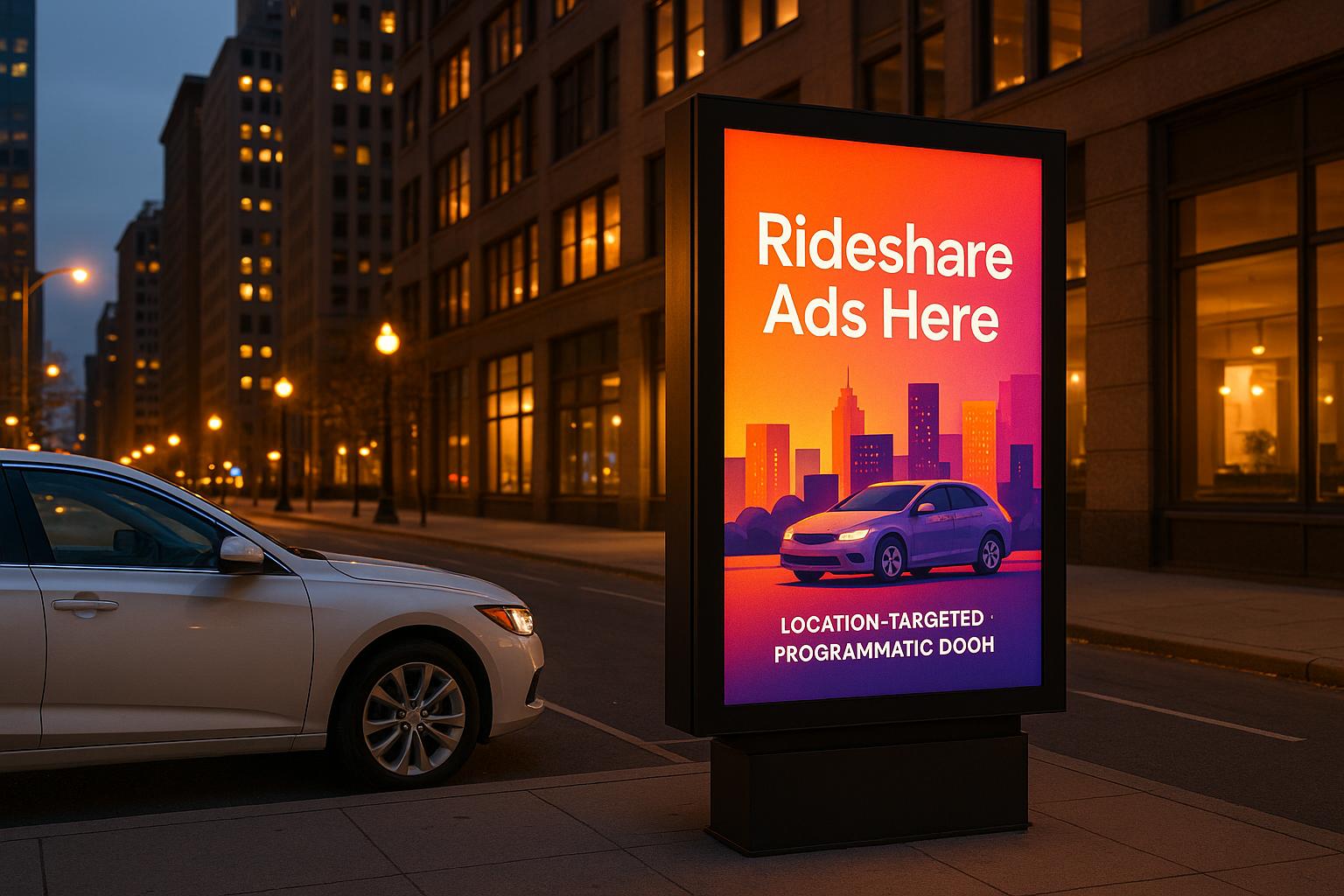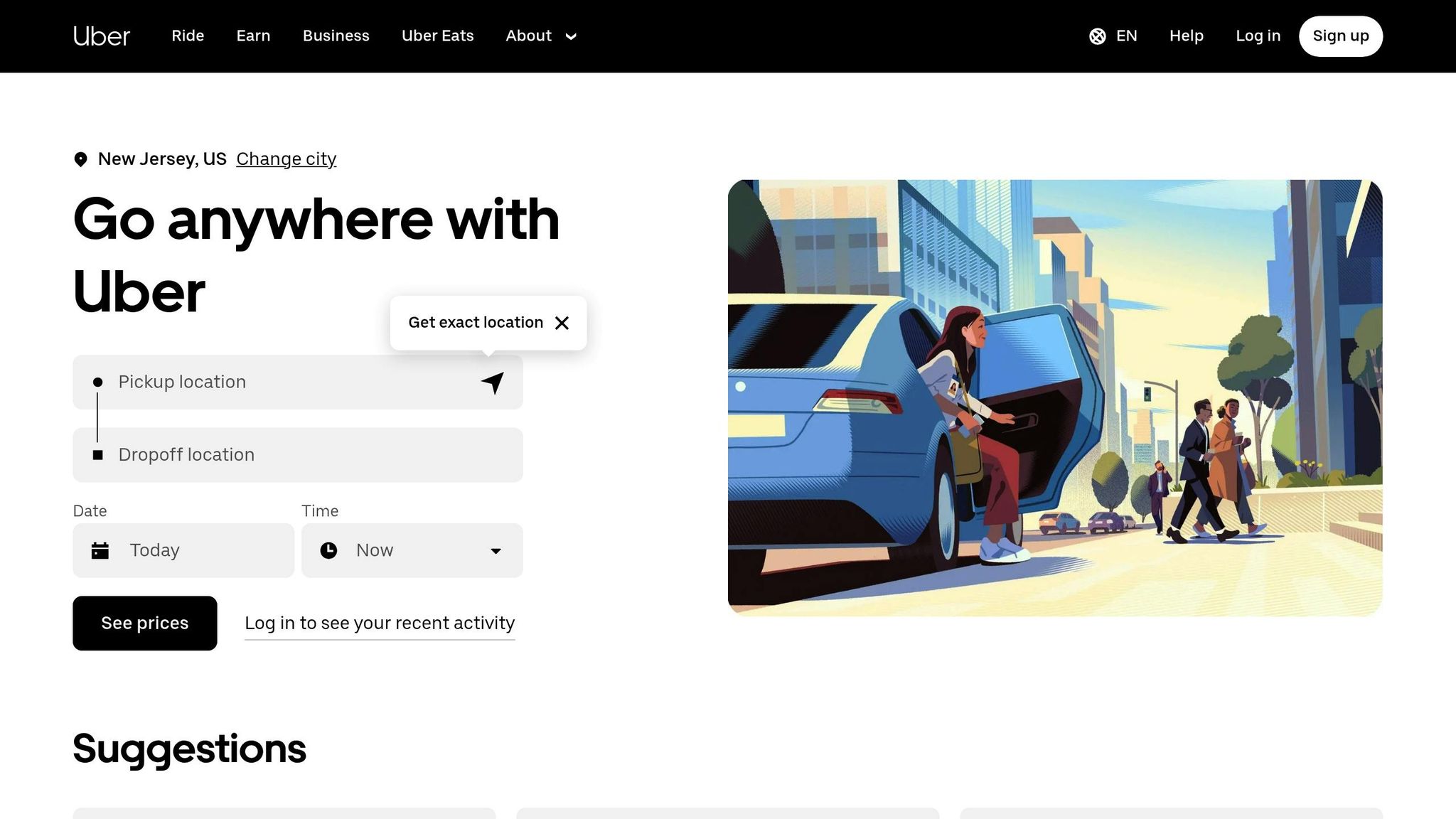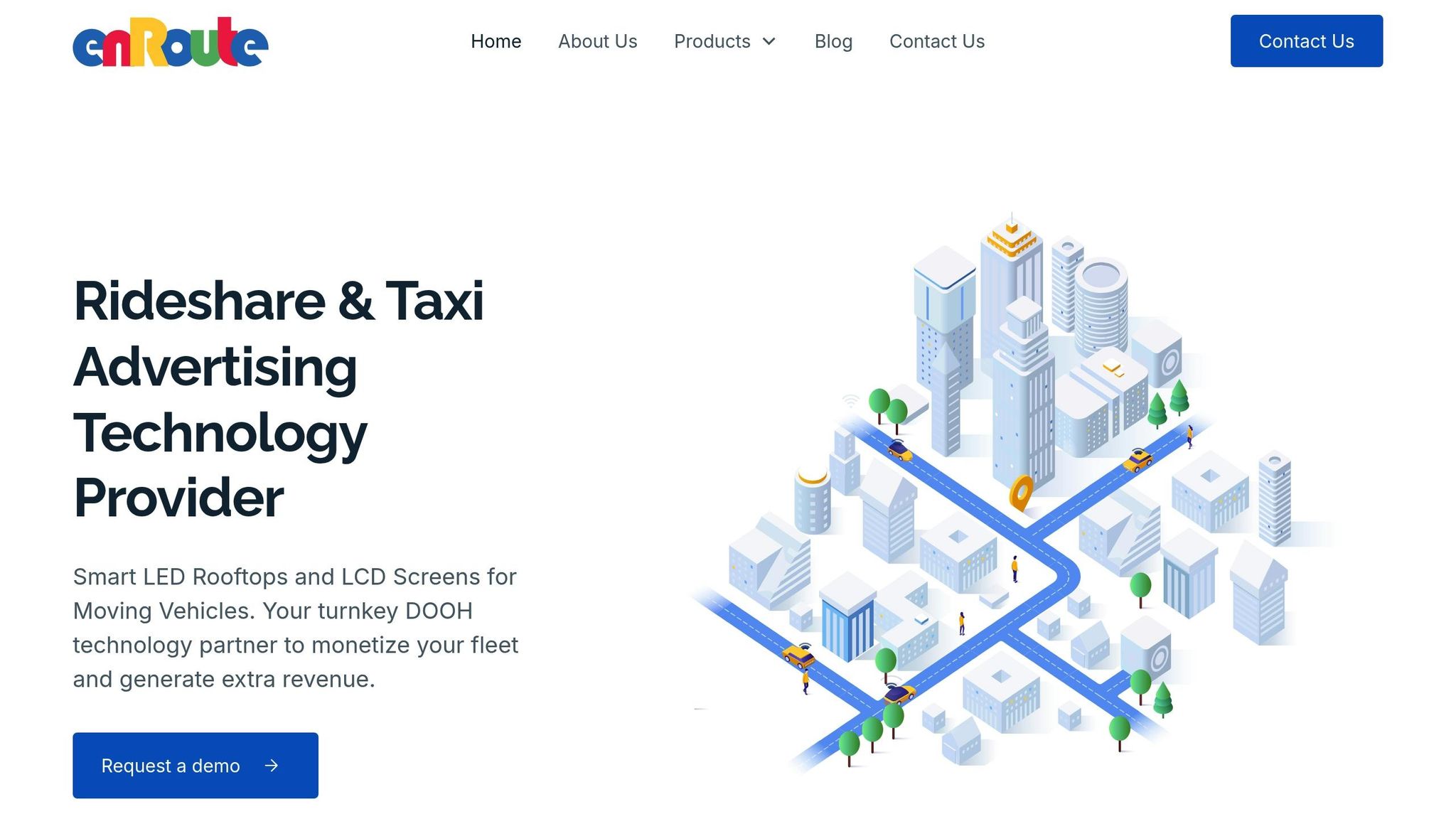Explore how programmatic DOOH advertising is revolutionizing rideshare campaigns with real-time, location-targeted ads for maximum engagement.

Programmatic DOOH (Digital Out-of-Home) advertising is transforming rideshare campaigns. Unlike traditional static billboards, this technology uses automation to deliver real-time, location-specific ads. For rideshare vehicles, this means ads can target both passengers and pedestrians dynamically as the vehicle moves through the city.
The article compares two approaches:
Choosing the right platform depends on your goals, whether it’s dynamic, location-based campaigns or traditional, fixed-location advertising.


Enroute View Media zeroes in on programmatic DOOH advertising (digital out-of-home) with a unique focus: rideshare and taxi vehicles. Designed by industry veterans, this platform blends hardware and software to meet the demands of mobile advertising in the rideshare space.
The platform uses a combination of dual-sided rooftop LED screens and in-taxi touch-screen tablets to deliver ads. The rooftop screens target pedestrians and other drivers as vehicles move through city streets, while the tablets engage passengers directly during their rides, ensuring multiple touchpoints for ad delivery.
What sets this system apart is its motion-sensing technology, which adapts ad displays based on vehicle movement. For instance, when a car stops, the screens show detailed content, but while in motion, they switch to bold, eye-catching visuals. Plus, multi-language support ensures that ads resonate with diverse audiences as vehicles travel through different neighborhoods.
This combination of advanced hardware and smart design makes it easier to serve location-specific, dynamic content.
One of the standout features of Enroute View Media is its geo-time targeted advertising. The platform tracks vehicle locations in real time and adjusts ads based on where the car is and the time of day. For example, a restaurant chain can promote breakfast specials during morning commutes in business districts and shift to lunch offers when cars move into shopping areas.
It also integrates with programmatic ad networks, allowing advertisers to bid on ad inventory using familiar tools. Campaigns can be fine-tuned by geographic zones, time slots, and audience profiles, giving advertisers more control over their reach and effectiveness.
To complement its dynamic ad delivery, Enroute View Media offers real-time analytics and reporting tools. These tools provide advertisers with instant insights into campaign performance, showcasing key metrics like impressions and engagement levels across different locations and times. The cloud-based system ensures that performance data is accessible and actionable.
The platform’s flexibility extends to its monetization options. Advertisers can adjust customizable CPM rates based on factors like route popularity or time of day, helping fleet owners and marketers maximize their ad revenue.
Additionally, white-labeled solutions allow marketing agencies and fleet managers to offer rideshare advertising under their own branding, while still relying on Enroute View Media’s infrastructure. For larger operations, the platform includes API access for custom integrations and advanced campaign management.
With a three-tier pricing structure, ranging from single-vehicle setups to enterprise-level solutions, Enroute View Media caters to everyone from individual drivers to large-scale fleet operators. This ensures flexibility and scalability for businesses of all sizes.
Traditional programmatic digital out-of-home (DOOH) platforms are all about fixed displays. Unlike rideshare-focused solutions, these platforms stick to static digital advertising on billboards, transit stations, malls, and airport terminals. This stationary approach is a stark contrast to the mobility-driven nature of rideshare ads and sets the stage for a deeper look at their ad formats and capabilities.
Standard programmatic DOOH platforms rely on digital billboards, transit shelter displays, mall kiosks, and airport screens. These displays are designed to reach local audiences throughout the day. The ad formats typically include static images, short video loops, and simple animated graphics.
One key characteristic of these platforms is their use of standardized screen sizes and display ratios, which means advertisers must create content that fits specific dimensions. Unlike mobile solutions, these screens don’t adjust based on movement or audience interaction. Ads are shown on fixed schedules, with each spot running for a set duration, usually between 10 and 30 seconds.
Content delivery is straightforward: pre-uploaded creative assets are distributed across the network and displayed according to predetermined rotation schedules.
Traditional DOOH platforms offer zone-based targeting, focusing on specific geographic areas where displays are installed. Advertisers can choose locations like downtown business districts, suburban malls, or busy highways, but targeting is limited to the fixed locations of the screens.
The platforms use foot traffic and vehicle count data to estimate audience exposure. Historical data helps advertisers identify high-traffic times and locations that align with their target audience. For example, campaigns can be scheduled to show breakfast deals during the morning rush or happy hour promotions in the late afternoon. However, this approach lacks the real-time precision found in mobile ad solutions.
While advertisers can tailor campaigns to specific time blocks, the targeting remains tied to the physical location of the screens rather than dynamic audience behavior.
Analytics on these platforms focus on impression-based reporting, estimating viewership using traffic data from each display location. Reports typically include metrics like total impressions, estimated reach, and basic demographic breakdowns.
The emphasis is on historical performance data, with advertisers receiving weekly or monthly updates about how their campaigns performed across various locations and time periods. Unlike mobile platforms, these systems don’t provide real-time insights.
When it comes to tracking campaign impact, attribution methods rely on broader tools like brand awareness surveys or foot traffic studies. This makes it harder to measure the immediate effect of specific ad placements compared to the direct engagement metrics available in mobile advertising.
Standard DOOH platforms operate on fixed CPM pricing models, with minimum monthly spending requirements typically ranging from $1,000 to $10,000. Pricing varies by market size and location quality - premium spots like Times Square command higher rates, while suburban areas are more budget-friendly. This structured pricing stands in contrast to the more flexible and dynamic models seen in rideshare platforms.
The availability of ad inventory depends on the platform’s network of physical screens. Advertisers are limited to locations where displays are already installed, which might not always align with their audience’s movement patterns or preferred routes.
When comparing mobility-driven rideshare advertising with traditional static DOOH (Digital Out-of-Home) methods, it’s clear that each offers distinct benefits and drawbacks. Choosing the right approach depends on your campaign goals, audience, and budget. Here's a detailed look at how these two advertising strategies stack up:
| Criteria | Enroute View Media (Rideshare) | Standard Programmatic DOOH |
|---|---|---|
| Ad Placement | Advantages: Mobile screens engage commuters with dual-sided displays and motion-sensing features Disadvantages: Limited by the number of available vehicles and smaller screen sizes |
Advantages: Large, attention-grabbing displays in high-traffic areas; standardized formats ensure visibility Disadvantages: Static locations miss mobile audiences; fixed schedules reduce flexibility |
| Geo-Targeting | Advantages: Real-time GPS allows ads to follow audiences as they move Disadvantages: Coverage depends on vehicle availability, which can vary unpredictably |
Advantages: Predictable audience exposure in fixed locations; historical traffic data aids planning Disadvantages: Restricted to specific locations; unable to follow moving audiences |
| Analytics | Advantages: Provides real-time performance data and engagement insights Disadvantages: Measurement standards are still evolving compared to traditional metrics |
Advantages: Relies on established impression-based metrics and extensive historical data Disadvantages: Offers limited real-time insights; attribution can be challenging, relying on estimated viewership |
| Monetization | Advantages: Flexible pricing models, including CPM options and white-label opportunities Disadvantages: Revenue depends on vehicle usage and the maturity of the market |
Advantages: Predictable pricing with premium location options; established cost structures Disadvantages: High minimum spending requirements and fixed CPM rates limit flexibility |
Rideshare advertising shines in urban areas where traditional billboards often struggle with visibility. Enroute View Media, for example, targets commuters during their daily travels, delivering location-specific messages at the most relevant times. However, this method has its challenges, particularly in areas with low rideshare activity or during off-peak hours when fewer vehicles are on the road.
Cost is another key differentiator. Traditional DOOH platforms often demand significant upfront investments, making them better suited for large-scale campaigns. Smaller businesses may find rideshare advertising more accessible, though its inventory can fluctuate based on vehicle availability and market conditions.
Measurement tools also set these methods apart. Standard DOOH relies on well-established impression-based metrics, which integrate seamlessly with traditional media strategies. Meanwhile, rideshare platforms offer real-time, highly detailed data, requiring advertisers to adapt their measurement practices to fully leverage these insights.
Geographic flexibility is a standout feature of rideshare advertising. Unlike static DOOH, which excels in fixed, high-traffic locations like airports and shopping centers, rideshare ads travel with consumers throughout their day. This creates opportunities for more personalized, context-driven messaging based on time, location, and travel habits.
Ultimately, the choice between these advertising platforms comes down to your objectives. Whether you prioritize mobility, cost efficiency, or established metrics, understanding these trade-offs will help you tailor your campaign for maximum impact.
When comparing advertising solutions, it's clear that Enroute View Media's rideshare-focused platform stands out from standard DOOH (Digital Out-of-Home) options for mobile campaigns. At the heart of their offering is the DigiStreamView "business in a box" solution, which includes hardware specifically designed for rideshare environments. What sets this platform apart is its ability to deliver real-time geo-targeting, ensuring that ad messaging aligns perfectly with each vehicle's location. This means advertisers can connect with consumers through hyper-local, contextually relevant messages as vehicles move through different neighborhoods - something static displays simply can't achieve. By combining mobility with real-time precision, Enroute View Media creates a unique advertising experience.
The platform also goes beyond precise targeting by offering in-taxi engagement tools that amplify campaign effectiveness. Built-in screens inside the vehicles provide a captive space for interactive content, allowing advertisers to gather immediate feedback. Additionally, integrated sensing technology provides detailed exposure reporting and real-time analytics. These features empower fleet operators and startups to fine-tune their campaigns continuously. With seamless programmatic integration, the platform not only simplifies mobile ad inventory management but also opens up new revenue opportunities for advertisers.
Enroute View Media's geo-targeting technology takes digital out-of-home (DOOH) advertising to a whole new level by delivering ads tailored to specific locations in real time. Whether it's a bustling neighborhood, a popular shopping district, or a major event venue, this system ensures your message connects with the right audience at the most opportune moment.
What sets this apart from traditional DOOH platforms is its ability to move beyond static or generalized targeting. By leveraging real-time location data, advertisers can create dynamic campaigns that resonate more deeply with their audience. The result? Increased engagement, more relevant ads, and a stronger return on investment for brands.
While Enroute View Media brings forward creative solutions for rideshare advertising, there are a few hurdles worth noting. Technical hiccups - like server overloads, synchronization lags, or regional limitations - can sometimes disrupt the seamless delivery of ads. On top of that, maintaining consistent technology implementation across various locations can be tricky, particularly when campaigns are scaled up.
That said, these issues are fairly typical for advanced advertising platforms. With thoughtful planning and robust support systems, they can be addressed to ensure smooth and reliable programmatic DOOH advertising for rideshare campaigns.
Enroute View Media's real-time analytics provides advertisers with instant insights into how their campaigns are performing. This capability lets advertisers make quick adjustments as needed, ensuring that their ads connect with the right audience at the right moment for the best possible results.
By analyzing detailed metrics such as audience engagement and location-specific performance, advertisers can refine their strategies to boost ROI and create highly targeted, impactful campaigns.
Need pricing details?